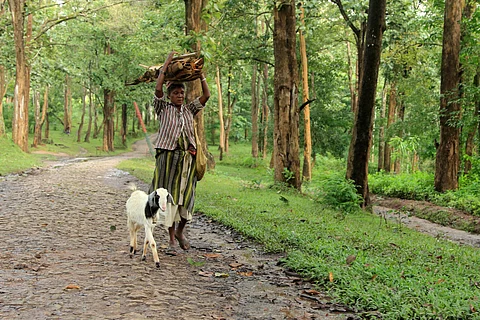

Sixteen years since The Scheduled Tribes and Other Traditional Forest Dwellers (Recognition of Forest Rights) Act, 2006 (also known as FRA) was introduced in January 2008, forest dwellers continue to face significant hurdles. Only three states in India have recognised a notable number of Community Forest Resource (CFR) rights, with Maharashtra being the only state where these rights have been operationalised, an analysis has noted.
In the remaining states, violations of these rights are still prevalent.
The study titled Democratising Forest Governance: Challenges Old and New which was led by Sharachchandra Lele and Geetanjoy Sahu, has highlighted that democratising forest governance remains a major challenge. Over 100,000 forest dwellers have been displaced due to the creation of protected areas by the National Tiger Conservation Authority (NTCA), which has also directed the relocation of 64,801 families living in core tiger reserve areas.
Lele points out that more than 300,000 hectares of forest land have already been diverted for development purposes, including mining.
The study also addresses the FRA’s role in India's commitment to sequestering 2.5 gigatonnes of CO2 equivalent through the forest sector and the international funding mechanisms such as REDD+ (Reducing Emissions from Deforestation and Forest Degradation).
However, there are concerns that carbon forestry projects, or “restoration” projects, could become another form of green displacement. This would exacerbate the displacement already caused by tiger reserves, regardless of whether tigers are present.
India has approximately 250 million people dependent on forests, with nearly 170,000 fringe-forest villages spread across 34.6 million hectares, excluding the Northeast region. Lele and Sahu’s study compared data on potential CFR rights recognition and found that states like Chhattisgarh and Maharashtra were the "best performing," but even they only recognised 36 per cent and 24 per cent of the potential area, respectively. Odisha followed in third place with a 10 per cent recognition in the number of villages covered, though only about two per cent of the area was acknowledged.
States such as Jharkhand, Gujarat, and Karnataka saw minimal progress, with less than two per cent of the area recognised, while forest-rich states like Madhya Pradesh, Rajasthan, West Bengal, Telangana, and Andhra Pradesh remain at zero recognition.
The study found that the denial of CFR rights remains a major barrier for the majority of forest dwellers in peninsular India. This has led to the degradation of forests or their strict control by the forest department, resulting in logging at the expense of ecosystem health and local needs.
Recent policies, such as the Green Credits Rules, which were eventually shelved, failed to address community rights and consent. Local communities are under constant pressure of displacement due to conservation and infrastructure projects, including mining, dams, and highways.
The number of protected areas in India has increased by 72 per cent between 2000 and 2023, with the number of tiger reserves rising from 27 to 57. However, this conservation model continues to assume the eviction of local communities. The NTCA’s letter highlights this trend, where forest departments are reluctant to accept CFR claims within protected areas, and voluntary relocation fails to acknowledge the rights of the people affected.
Post-amendment changes to the Forest Conservation Rules in 2014 have led to further violations of forest dwellers’ rights. Of 125 applications for forest clearance for mining, none had considered recognised community rights. The central government has further diluted the process, with the 2022 Forest Conservation Rules eliminating the need for states to settle these rights.
Despite these challenges, there is still hope, as Maharashtra has demonstrated that community mobilisation can lead to positive change.
In Gadchiroli district, for example, local communities have invested in building institutions that view them as "rights-holders" rather than "beneficiaries." These institutions have helped generate local employment, enhance incomes, and conserve forests.
Inspired by Maharashtra's success, other states like Chhattisgarh and Karnataka are now demanding greater involvement in the management of protected areas and ecotourism, instead of being displaced.